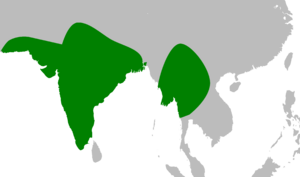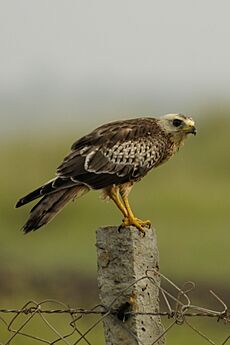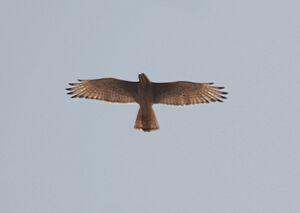White-eyed buzzard facts for kids
Quick facts for kids White-eyed buzzard |
|
|---|---|
 |
|
| Adult showing the typical throat, mesial stripe and pale iris, India | |
| Conservation status | |
| Scientific classification | |
| Genus: |
Butastur
|
| Species: |
teesa
|
 |
|
| Synonyms | |
|
Poliornis teesa |
|
The white-eyed buzzard (Butastur teesa) is a medium-sized hawk found in South Asia. It's different from the "true buzzards" you might know. This bird gets its name from its special white eyes.
Adult white-eyed buzzards have a reddish-brown tail. They also have a white throat with a dark stripe down the middle. Their head is brown, and the top of their wings are pale. Unlike true buzzards, they don't have dark patches under their wings. Instead, the entire underside of their wings looks dark. These birds often sit still on branches for a long time. They also fly high in circles, looking for insects and small animals to eat. During breeding season, they make a lot of noise. You might hear several of them calling as they fly together.
Contents
What Does the White-Eyed Buzzard Look Like?
This hawk is slim and not very big. It's easy to spot because of its bright white eyes. It also has a white throat with a dark stripe in the middle. Sometimes, you can see a white spot on the back of its head. When the bird is sitting, its wing tips almost reach the end of its tail. Its beak area (called the ceres) is bright yellow. The bird's head is dark, and its belly has dark stripes.
When it flies, its narrow wings look rounded. The tips of its feathers are black. The underside of its wings looks dark. The top of its wings shows a pale bar against the brown feathers. Its reddish-brown tail has darker stripes and a dark band near the end. Young white-eyed buzzards have brownish eyes. Their forehead is whitish, and they might have a wide stripe above their eye. The only bird that looks similar is the grey-faced buzzard. But adult grey-faced buzzards have a clear white stripe above their eyes. Baby white-eyed buzzards are reddish-brown. This is different from most other baby birds of prey, which are usually white.
Where Do White-Eyed Buzzards Live?
You can find white-eyed buzzards all over South Asia. They live across India, especially in the flat plains. They can also be found up to 1000 meters high in the Himalaya mountains. These birds live year-round in Iran, Pakistan, Nepal, Bangladesh, and Myanmar.
There might be a group of these birds in Indonesia, but they are very far away from the main population. These birds have whiter feathers on their legs and belly. This might mean they are a new type of white-eyed buzzard. They are not found in Sri Lanka or the Andaman Islands. They visit northeastern Afghanistan during the summer. They mostly live in open forests or farmed areas. In some places, there are many of them, but their numbers are going down.
How Do White-Eyed Buzzards Behave?
White-eyed buzzards are usually seen flying alone in warm air currents. They also like to sit very still on perches. Sometimes, you might see groups of two or three birds together. They make a sound like a "mewing" or a falling whistle. They repeat this call when pairs are flying high together. They are especially noisy during the breeding season.
|
||||||||||||||||||||||||||||||||||||||||||||||||||||||||||||||||||||||||||||||||||||||||||||||||
| How Butastur species are related to other birds in their family. |
What Do White-Eyed Buzzards Eat?
These buzzards mainly eat large insects. This includes locusts, grasshoppers, and crickets. They also hunt small animals like mice, lizards, and frogs. Sometimes, they might eat crabs found near wet areas. They have even been seen catching larger prey, such as the black-naped hare.
Reproduction and Life Cycle
The breeding season for white-eyed buzzards is from February to May. They build a loose nest made of twigs. It looks a bit like a crow's nest. They sometimes place it in a tree that has lost its leaves. A female usually lays three eggs. The eggs are white and usually don't have spots. Both the male and female help build the nest. They also both help feed the young birds. Only the female sits on the eggs to keep them warm. This takes about 19 days until the eggs hatch.
Images for kids







